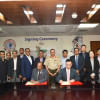A golden opportunity for Bangladesh?

Over the last four decades, China has established itself as the leading hub for manufacturing on a global scale. In the late 1970s and early 1980s, the implementation of economic reforms under Deng Xiaoping facilitated the entry of foreign direct investment (FDI) in China's economy, prompting numerous companies to shift their manufacturing operations to the country. Nonetheless, the persistent difficulties faced by the world's second largest economy, including geopolitical tensions with the United States, environmental regulations and overcapacity in manufacturing have led China to relocate various industries to friendly nations in Southeast Asia, South Asia and Central Asia. It's pertinent to analyse China's industrial relocation and how Bangladesh can benefit from it.
Why are Chinese industries relocating?
First, China is undergoing a significant transformation, influenced by a variety of economic, geopolitical, environmental and policy issues. This transition is driving Chinese companies, especially in low-end manufacturing, to explore alternative regions that provide improved market access with greater outputs. China has been experiencing an upsurge in production wages and production costs in recent times, which has led to a decline in the cost competitiveness, once considered to be the strength of Chinese economy. Furthermore, stringent environmental regulations have led to a shift in compliance expenses that's influencing rendering domestic industry to other regions. Last year, Chinese Premier Li Qiang outlined the yearly economic growth target of five percent during his inaugural working report at the National People's Congress. He emphasised the need for a significant advancement through the acceleration of industry modernisation and the "development of new quality productive forces." The approach that Li Qiang spoke of entails a systematic transition towards high-end, smart and clean manufacturing sectors, with a strategic relocation of several domestic industries to emerging economies in their geographical proximity. In the context of emerging economies, Bangladesh presents itself as a suitable region for attracting these shifting industries.
Additionally, the ongoing tensions in US-China trade and broader decoupling trends are prompting Chinese firms to adopt a "China Plus One" strategy aimed at diversifying their production bases to mitigate geopolitical risks. Southeast and South Asia have emerged as significant relocation centres in response to rising tariffs and intensified trade barriers between China and Western countries. Chinese firms recognise that the developing nations in South and Southeast Asia possess adaptable tariff regulations when engaging with the US and Western markets. In the same scenario, Chinese FDI in Mexico reached a 13-year high in 2023, with capital expenditure surging to $5.6 billion, up significantly from $267 million in 2018. This "near-shoring" move was intended to exploit benefits of exporting goods to the US produced in Mexico under the USMCA agreement.
Moreover, in the context of China's recent five-year plans, it is evident that the country is strategically shifting its focus from its previous role as the "world's factory," which was characterised by the production of low-cost, low-tech goods supported by competitive labour costs and supply chain efficiencies. China's new industrial policy of "Made in China 2025" aims to enhance the manufacturing capabilities of Chinese industries, transitioning from labour-intensive operations to a more technology-driven, sophisticated industrial hub. The focus on high-tech productive forces, including electric vehicles (EVs), artificial intelligence (AI), and cutting-edge semiconductors, is expediting the relocation as well.
Bangladesh as a potential destination
Bangladesh has always been a viable destination for Chinese firms as it offers some significant benefits that Chinese companies enjoy at home. Till date, Bangladesh can offer the most competitive wages compared to other viable destinations in the region. The average monthly wage of an industrial worker still remains below $150 that makes it lucrative for manufacturing industries. Additionally, the young labour force in Bangladesh presents a significant long-term benefit for industrial production. The country boasts a demographic dividend where more than 65 percent of its population is under 35 years old. Moreover, the geographical location of Bangladesh in the crossroad of the Indo-Pacific region makes it a suitable transportation and logistical hub for international shipping of produced goods. As of present circumstances, Bangladesh can offer duty-free access to European markets as well with zero tariffs on EBA (Everything but Arms) scheme and curtailed tariffs on goods exported to the US, Japan, Australia and other countries. Bangladesh also offers dedicated Export Processing Zones (EPZs) and Special Economic Zones (SEZs) for attracting FDI, especially in the coastal region.
Chinese industries relocating matter for Bangladesh
The Bangladesh Economic Zones Authority (BEZA) has established a structured timeline aimed at operationalising five economic zones within the next two years, out of a total of 100 proposed zones all over Bangladesh. These zones are vital for attracting FDI from Chinese firms aiming to relocate their operations. It is noteworthy that China holds the second position after Bangladesh; 108 companies have invested in EPZs. According to data from the Bangladesh Bank, FDI inflows reached $1.46 billion in FY2023-24, with $424 million of this total attributed to investments in the export processing zones. Ashraful Kabir, who serves as a member for investment promotion at BEZA, highlighted that in addition to RMG products and accessories, 48 percent of the products manufactured in the EPZs have now diversified into other categories. He noted that decreasing dependency on RMG production allows the EPZs to enhance Bangladesh's economic stability by promoting product diversification and expanding export opportunities. Chinese firms invested $283 million in FY2023-24, and China is the third largest FDI source for Bangladesh that stands with $1.56 billion in total as of June 2024.
It is worth noting that the growth in the manufacturing sector has been sluggish compared to the service sector. In 2013, the number of economic units of the industrial sector was 9.2 million, which increased to 1.04 million in 2024. The growth rate has increased by 15.38 percent in a decade. The slow rate of pace in Bangladesh's economy does not end here; the number of unemployed people in the country has increased to 2.66 million, according to the Bangladesh Bureau of Statistics (BBS) for the period of July-September 2024. Bangladesh must feel the urge to attract Chinese industries to invest and increase FDI to overcome this stagnation. The head of the Chinese Communist Party's (CCP) International Department, Liu Jianchau, said to Bangladesh Foreign Affairs Adviser M Touhid Hossain during his recent visit that China is thinking of relocating its industries and they are considering Bangladesh as an option. They also think that exporting the manufactured goods to other countries from Bangladesh and the matter of incentives in exports will be beneficial to China.
Challenges ahead
However, the existing infrastructure presents significant challenges with shortage of energy and port delays contributing to increased expenses and diminished investor trust. The government has initiated large-scale EEZs; however, the pace of project implementation is not satisfactory. It is an undeniable fact that Bangladesh has administrative inefficiency and bureaucratic complexities in attracting foreign investment, which introduces an additional layer of complexity. Policy reforms are needed now to attract Chinese investment despite advantages. Tax concessions, tax holiday, and ease of doing business should be prioritised to attract relocating industries. Bangladesh has a shortage of skilled labour force to propel newly relocated industries. It will continue to be a significant area of concern if no comprehensive action plan from the government is taken.
Foreign investors endure significant challenges in Bangladesh due to intricate, often bureaucratic, approval procedures from various government agencies that must be fixed to harness relocating Chinese industries. Regional competitors like Vietnam and Indonesia have already streamlined their investment frameworks to facilitate the relocation of Chinese industries. Should Bangladesh not implement necessary reforms to its regulatory framework and expedite investment processes, it may face significant challenges in maintaining its competitive edge in international trade.
Md Sakib Hossain is a political and international relations analyst based in Dhaka.
Views expressed in this article are the author's own.
We welcome your contributions and analysis of global events, and responses to our articles. To submit articles to Geopolitical Insights, please send an email to [email protected].
Follow The Daily Star Opinion on Facebook for the latest opinions, commentaries and analyses by experts and professionals. To contribute your article or letter to The Daily Star Opinion, see our guidelines for submission.

 For all latest news, follow The Daily Star's Google News channel.
For all latest news, follow The Daily Star's Google News channel. 










Comments